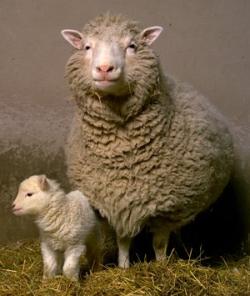Dolly the sheep
|
|
The sheep named Dolly (July 5, 1996 - February 14, 2003) was the first mammal to have been successfully cloned from an adult cell. She was created at the Roslin Institute in Scotland and lived there until her death nearly seven years later. Scientists did not announce her birth until February 22, 1997, however.
The name "Dolly" came from a suggestion by the stockmen who helped in the process, in honour of Dolly Parton, because the cloned cell was a mammary cell [1] (http://news.bbc.co.uk/hi/english/sci/tech/newsid_769000/769915.stm). The particular technique that was made famous by her birth, is somatic cell nuclear transfer, in which the nucleus from one of the donor's non-reproductive cells, is placed into a de-nucleated embryonic cell (which is then coaxed into developing into a fetus). When Dolly was cloned in 1996 from a cell taken from a 6 year old ewe, she became the centre of a controversy that still continues today.
On April 9, 2003 her stuffed remains were placed in state at Edinburgh's Royal Museum of Scotland.
| Contents |
The controversy
In 1999, research was published in the journal Nature, suggesting that Dolly may be susceptible to premature aging [2] (http://news.bbc.co.uk/1/hi/sci/tech/353617.stm), due to shortened telomeres in her cells. It was speculated that these may have been passed on from her parent, who was six years old when the genetic material was taken from her, so that Dolly may have been genetically six years old at birth. However, Dr. Steven Pallickal of UCLA indicated that most cloned animals actually have telomeres of normal length and in serial clones the telomeres are actually getting longer in each successive generation.
Possible signs of this were reported in January, 2002, when Dolly was five years old. She had developed a potentially debilitating form of arthritis at an unusually early age. This supported the theory of premature senescence, although Dr. Dai Grove-White of the Faculty of Veterinary Science at Liverpool University was reported as saying, "Conceivably arthritis could be due to the cloning but equally it could not be. For all we know, she may have damaged her leg jumping over a gate and developed arthritis."
The arthritis further fueled worry among some that this form of cloning may not be appropriate for mammals, and there is now a consensus both within and outside the scientific community that at this point the risk of unforeseen effects of cloning on the clone makes experiments in human reproductive cloning premature and unethical.
Supporters of this method of cloning counter that the technique used to clone Dolly simply needs to be refined. However, others contend that with our very limited understanding of the nascent field of applied genetics, we cannot, and should not, attempt to control the action of so many genes at once. Yet many outside of the scientific community have stated that this is vindication for their initial assertions that any form of cloning is ethically wrong and should be banned.
Her death
Dolly was put down on February 14, 2003, due to complications from a lung infection. The disease most often causes complications in older sheep, leading to further speculation that Dolly aged prematurely. Roslin scientists, however, state that they do not think there is a connection with Dolly being a clone, and that other sheep on the farm had similar ailments. A post-mortem examination is planned for Dolly and it is hoped that this test will indicate whether or not her illness was connected to her being a clone.
The reasons for Dolly
Dolly was created by agricultural research scientists, who were being funded to make the perfect sheep, for the purposes of more efficient agricultural production. In the 1990s the sheep population in Scotland was around nine million, and there was certainly no shortage of lamb or wool. Conventional animal breeding had already developed excellent pedigree breeds of sheep for all the environmental conditions and agricultural systems in the UK. Critics have suggested that the resources spent on creating Dolly could have been directed to much more practical research, whether agricultural or otherwise. They have argued that Dolly is perhaps the perfect example of scientists focusing in on highly specialised areas, to such an extent that they are no longer able to see the wider picture, and the implications of their endeavours.
Dolly's legacy
After the cloning was successfully demonstrated by Dolly creators, many other large mammals have been cloned, including horses and bulls. Dolly, who became the first famous adult cloned sheep, was successfully cloned in 1996, but was not shown to the public until the following year. Cloning has left the realm of science fiction and has become a realistic technology, with its risks and promises of great medical progress. Cloning has already become an option for preserving animals that may become extinct and bringing back to life replicas of pets, such as cats and dogs. Work is slowly progressing on the project to recreate the mammoth and other prehistoric animals. In regards to humans, despite the continued opposition, cloning may become a valid reproductive strategy in addition to IVF, surrogate mothers, adoption and traditional reproduction. It has also paved the way to make the controversial practice of genetic engineering of human children more acceptable, first by genetic screening to decrease the risks of a hereditary diseases, second to ensure genetic compatibility for stem cell transplantation to siblings [3] (http://www.boston.com/news/nation/articles/2004/05/05/lab_helps_create_babies_to_aid_sick_siblings/) and potentially to improving the genetic code of the children to prolong their life span, strengthen the immune system, and increase the intelligence.
Related articles
External links
- Dolly the Sheep, 1996-2003 from the Science Museum, London (http://www.sciencemuseum.org.uk/antenna/dolly/index.asp)
- Roslin Institute: Update on Dolly and nuclear transfer (http://www.roslin.ac.uk/public/01-12-98-dnt.html)
- Photos of Dolly and other cloned animals at Roslin (http://www.roslin.ac.uk/imagelibrary/)ca:Ovella Dolly
cy:Dafad Doli de:Schaf Dolly es:Oveja Dolly fr:Dolly (brebis) fy:Dolly he:הכבשה דולי nl:Dolly (schaap) pl:Owca Dolly pt:Ovelha Dolly fi:Dolly-lammas sv:Dolly (får)

